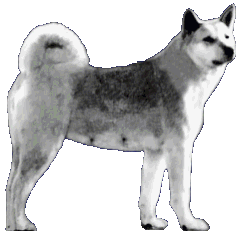 |
FAMOUS JAPANESE DOGS
KIYOHIME
OF (MIURA OF AKITA)
By Ryonosuke Hiraizumi
HIRAIZUMI, RYONOSUKE, "KIYOHIME
(OF MIURA OF AKITA)"
AIKEN NO TOMO pp. 428-429, (AUGUST) 1996.
Translated by Tatsuo Kimura
|
I have been asked to discuss a famous Akita dog, its
achievements, distinguishing features and era.
This is not an easy task for me, now being in
my twilight years and not having written any articles for almost a decade.
However, I shall make an attempt to present my views.
Photographs of Akita dogs awarded for producing outstanding
dogs are on display at the Akitainu Hozonkails Museum.
They are: 1. Ichinoseki-goma-go (male, brindle), 2.
Goromaru-go (male, pinto), 3. Kiyohime-go (female, red), 4. Taihei-go (male, red), 5.
Tamakumo-go (male, brindle), 6. Azumazakura-go (male, brindle), 7. Kumomaru-go (male,
brindle) and 8. Daiunme-go (female, brindle).
However, many excellent dogs have been also produced before
and after these dogs.
The Nihoninu Meiken Shashinshu 1 (Photo Albums of Famous Japanese
Dogs, Volume 1) shows the following dogs: Tochini-go (of Izumi Shigeru of Akita), male,
brindle; Babagoma-go (of Nyui of Akita), sesame; Hanyutaro-go (of Izumi Senko-en), male,
brindle; Date-go (of Tayama), female, red; Matsumine-go (of Watanabe of Akita), male,
brindle; Jugoro-go (of Kaneyama-so of Akita), male, sesame; Tsubaki-goma-go (of Watanabe
of Akita), male, sesame; and Arawashi-go (of Araya of Akita), male, sesame.
Selecting the most outstanding Akita dog from the foregoing
list of famous dogs is difficult. One should not ask which Akita dog is the best among
these but should ask how the Akita dog of the future be molded from these dogs?
Coat colors in the Akitainu Hozonkai Standard of today
include white, black, red, sesame, brindle and pinto. However, only the red, brindle and
white are being shown today.
Most of the questions today are focused on the faces of
dogs with the red coat.
For that reason, I have decided to discuss Kiyohime-go. I
believe that the photograph in the Nihoninu Meiken Shashinshu (A Photo Album of Famous
Japanese Dogs, Volume 1) was taken when she was not in the best of condition. She appears
as if this was taken just after giving birth. Normally, she had a beautiful coat. This
photograph was also taken from an oblique angle from the rear, and I am not fond of this
shot.
Red dogs of today have too much white coat on the face.
Kiyohime-go had the red coat from the forehead and along the nasal ridge. I believe that
white should be limited only to the cheeks.
Increasingly, many of the Akita dogs of today seem to have
more white on the face and this should be not be allowed to continue.
When I met the late Mr. Hajime Watanabe of Nippo either
prewar or immediately after the war, he told me that the tendency is for red to fade in
breeding red Shiba dogs. Therefore, he told me that one should breed these Shiba dogs with
the black coat at least once.
Kiyohime-go was a fine dog that quickly won the Sakushutsu
Korosho (Award For Producing Outstanding Dogs) at Akiho. Although Kiyohime-go was a fine
dog produced from combining the Ichinoseki and Taihei lines, she had the features of the
Taihei line.
Her body form, adequate height, beautiful red coat, waxing
in dignity and great ring manners enabled her to beat the male competition so that she was
the first bitch to go Best-In-Show at the Akitainu Hozonkyokai (Akihokyo) Show.
Taihei-go started a red line of Akita dogs beginning with
Yohei to Fudo (Akemi) to Meigyoku and Tamakiyota. Kiyohime-go was the dog at its peak and
produced many outstanding dogs in various regions thereafter.
Tamakumo-go and Kiyohime-go produced Kiyome-go. Kiyome-go
produced Daiunme-go, which produced Kumohibiki-go and Nanun-go. Nanun-go produced
littermates Kumomaru-go and Tetsuyuki.
Not only are the main bloodlines of the brindle, red
sesame, red and white included, but by maintaining the basic features of the Akita dog and
raising its purity, one could say that Kiyohime prevented the deterioration of the breed.
Since female foundation dogs are exceedingly fewer when
compared to the number of male foundation dogs, their influence is at a disadvantage, so
that showing their power over those of the male foundation dogs is extremely difficult.
A given bloodline may be popular during its era, but they
soon fade away and are usually forgotten. However, those that steadfastly continue to
shine over others that soon go into eclipse may reveal the importance of that Akita dog's
bloodline.
My hope is that the Akita dog of the future should be
produced by looking at the excellent Akita dogs of the past that had the features such as
dignity and sobokukan (simple and pristine air).
KIYOHIME-GO'S PEDIGREE
Registry Numbers: Akiho 9930. Akikyo 1898 Gender: Female. Date of Birth: 12/19/1950. Coat
Color: Red.
Jugoro
Tsubakigoma (of Watanabe of Akita)
Toshi
Goromaru (of Narita of Akita)
Aka (of
Ichinoseki)
Futatsuigoma (of Narita of Akita)
Hakuun (of Akita)
Sirogumo (of Akita)
Kiyohime
Shinakita (of
Kikuchi of Akita)
Datenohana (of Ishida of Akita)
Datenohaname (of
Akita)
Chinpei (of Ito of Akita)
Toyo (of
Akita)
Kagetsu (Peace) (of Akita)
Aka
(of Nagasaki of Akita)
|

|